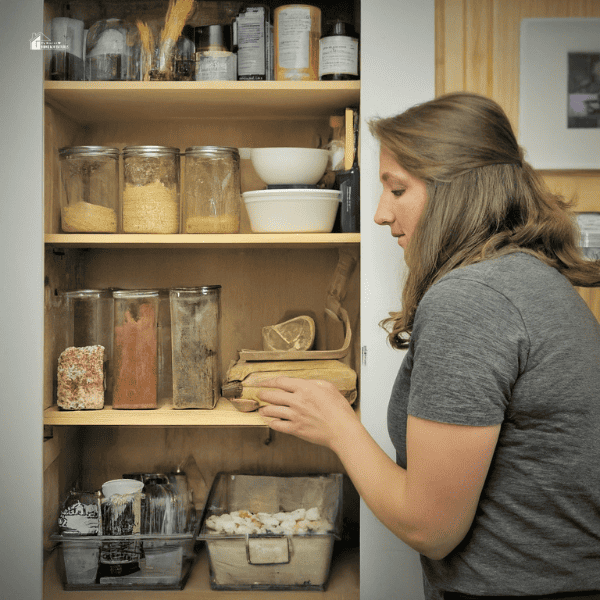Cooking on a Dime: Inexpensive Kitchen Upgrades for Family Happiness
This post may contain affiliate links which might earn us money. Please read my Disclosure and Privacy policies hereA strong smoke smell fills the air, and you can catch the aroma of cooked steak. You chase the smell, thinking about its mouth-watering taste.
You then see your whole family in the kitchen, united by great food at home.
Something else strikes you all of a sudden (and it’s not the food this time). The allure of food contrasts with the total chaos in the kitchen. It looks as if a storm has gone by — ingredients everywhere, measuring cups, spoons, ladles, trays, plates — the kitchen is a mess!
The kitchen isn't just for cooking – it's where the family comes together, feels at home, and stays in touch. This article looks into how important a well-working kitchen is for a happy family life. We pay attention to cost-effective changes that balance low prices with quality and speed.
Made for families on a budget, this guide gives helpful advice to improve their kitchen without spending too much money. By using these tips, you can turn your kitchen into a workable and friendly area. Let’s begin.

Section 1: Organize Your Kitchen for Efficiency
First, keep your kitchen tidy.
It’s not just for looks — a tidy kitchen makes it easier to find the food and tools you need. This helps make meal preparation less stressful. Picture how good it feels to easily find what you want all the time.
Kickstart a more straightforward cooking routine by knowing how to organize your kitchen. You can start by cleaning up your kitchen counter and organizing storage to make cooking easier. This will also help create a feeling of peacefulness and order in the kitchen.
Another way to arrange your kitchen is by using slide-in dividers in drawers that tidily separate and sort out things like utensils. Put things you use often at the front for quick reach and cut down time spent looking for certain tools while cooking. Cabinet organizers for pots and pans help stop stacking cookware. This stops scratches and makes it easy to find the right pot without making noise.
Section 2: Smart Appliance Upgrades on a Budget
After cleanliness comes decisions about devices. Choosing energy-saving appliances isn't only good for the environment; it's a smart choice that can reduce your monthly utility costs and increase your home's value. These new gadgets are made to save power without losing quality. Yes, some might cost more at the start but think of it as an investment that saves money in the long run.
The automatic chapati maker is a smart investment for families promoting healthy eating with various types of flour. It automates the process of making rotis, facilitating the preparation of fresh and wholesome flatbreads hassle-free. Despite a higher initial cost, it's a valuable investment for fostering nutritious eating habits.
Look at Energy Star-rated home appliances, such as fridges and dishwashers. They're known for their good value while being efficient in using power. For example, a basic Energy Star fridge makes less heat and uses less power. You can buy one for as low as $500. A STAR-certified fridge can save over $220 in 12 years. If this isn’t enough to convince you, these fridges are 10-30% better at using energy than those that just meet the basic government rule. They can last longer and work well to keep quality up.
As you scout for upgrades, research goes a long way. You can tailor your appliance choices to your kitchen priorities (smart coffee maker, anyone?). Look out for seasonal sales, discounts, and manufacturer rebates; they can also substantially reduce your initial costs.
Section 3: Creative Storage Solutions
Now that you know how to keep your kitchen running well, the next question is, How do you make this cost less? But don’t go buying regular storage boxes just yet.
Make use of common items that you already have first. Use old glass jars to store dry things or change an old ladder into a fancy spot to hang your pots. A wall with magnetic strips can turn a blank wall into an organized place for knives. This makes it simple to access and get your food ready. These help to make the kitchen bigger by using high and rarely used places well.
These cheap options not only give good storage space but also add a bit of creativity to your kitchen's look.

Section 4: Budget-Friendly DIY Projects
Explore doing your own simple tasks at home to make your kitchen look better without spending a lot of money. How about painting? Maybe something bright if your kitchen’s stuck with a ‘millennial gray’ color (though nothing wrong with it if that’s your style!) What about just replacing your cabinets? Shaker-style cabinets are great for those who want a classic look.
Another cheap, do-it-yourself (DIY) project is to put in a backsplash. This makes your kitchen look more elevated and stops walls from getting dirty splashes on them. Backsplash tiles can be made from various materials. If you go slow (never rush DIY projects!), you can make it look tidy and save lots of cash.
Lastly, estimate the cost. You’ll find online a range of options depending on the size, height, and look that shows off your unique style.
Section 5: Thrifty Shopping Tips for Kitchen Essentials
Starting a kitchen makeover doesn't have to cost much, especially with DIY. You can find low-priced kitchen essentials by shopping smartly, like in thrift shops.
Second-hand shops and internet markets can be full of cheap things. Look at used options for pots, spoons, and small kitchen machines. These are usually much cheaper than buying new ones from a store. But it's essential to check prices and read reviews to ensure that you get good value for money and top quality.
Think about using green options to save money and help protect our planet. Bamboo things you use for food, bags made of soft silicon to store your meals, and glass containers help the earth stay cleaner.
When going to online stores, being patient is essential. Watch for sales, discounts, and package deals to save more money. Shopping smart is a talent that combines cost and quality, making sure your kitchen improvement is as cheap as it's enjoyable.

Section 6: Meal Planning and Prep for Savings
Planning meals helps your kitchen stay organized, saves money on groceries, and lowers food waste and can be made easier when you ensure that you have a designated food recycling bin for proper disposal. By carefully planning your weekly meals, you can spend wisely — purchasing only what you need, and using them properly.
This makes it less likely for unused stuff to stay in your cupboard too long. Sticking to a planned shopping list and avoiding impromptu grocery runs can significantly reduce monthly grocery bills and food waste.
Set aside a certain day or two, maybe on the weekend before starting your week to make plans and come up with a weekly menu. You can even prepare for meal prep (a little extra, but hey, it helps!) by chopping commonly used ingredients such as garlic, and onions, and even preparing the right amount of spices in small containers before your actual meal prep day. This way, you can just mix your food, cooking show style!
Moreover, you can save yourself energy — you don’t need to think about what to eat each day, no less prepare it.
A bonus pro tip: look for coupons and look at food clearance aisles. If you’re planning your meals properly, you can afford to buy cheaper food that will expire in a week or two — this is because you’ve planned to include it in your meals right in time!
Section 7: Maintenance and Repairs for Longevity
Keep your kitchen items from breaking down quickly by doing basic checks every now and then. This is the best way to save money on costly fixes or having to buy new items early.
Regular care requires little cost but big rewards. Small jobs like cleaning air vents, looking for leaks, and checking appliances can prevent minor problems before they become big. You can do simple home repairs like cleaning the fridge or clearing drain blocks.
These tasks are easy to add to your daily habits. But it's important to know when you need help from a professional. Finding and fixing problems early can help you avoid costly fixes later.
Think about which steps will save money, like fixing countertops or changing older parts. These make your kitchen tools last longer and avoid costly fixes or replacements.
Putting time and energy into routine care is an excellent way to make sure your kitchen stays valuable for many years.
Section 8: Involving the Family in Kitchen Upgrades
Make kitchen changes a family project to get a sense of togetherness and shared responsibility.
When including family in the kitchen improvements, it becomes more than just helpful; it turns into a place where everyone adds to make it cozy. Getting kids or others to help improve the kitchen makes your work easier and also helps build good memories and a feeling of pride for how the kitchen has changed.
Urge kids to join in activities they can do at their age, like tidying up cupboards or helping with food preparation, maybe even decoration. Teamwork on DIY tasks like painting cabinets or putting together furniture can be helpful and fun for young folks or grown-ups.
Just like when building IKEA furniture, you’ll get moments of laughter while painting or assembling your kitchen.

Section 9: Prioritizing Safety in Kitchen Improvements
When making changes to the kitchen, remember that safety is very important. Put safety first to protect your family's health and the money you spend on kitchen equipment.
Doing things right, like putting up shelves completely or connecting the right parts (and not overlooking any!), helps make your changes last longer too. It also stops dangerous situations from happening. Some common renovation mistakes include not measuring (this is a big one as it affects your whole design), not considering clearances or the space, not planning out storage, or forgetting electrical elements.
The money saved from being safe is endless. Avoiding accidents, damages, or mistakes in your kitchen stops extra costs and keeps it working nicely. Putting time and focus on safety during improvements helps protect your family's physical health and money.
Section 10: Quality Over Quantity
When searching for a good kitchen that lasts, focus on how well it's made instead of its size (size doesn't always matter!)
It's easy to be attracted by cheap choices, but spending money on good kitchen items is worth it in the long run. At first, good quality things may cost more. But they last longer and work better. See it as a way to spend money on your kitchen's future.
Some kitchen tools are good to buy even if they initially cost more. A strong group of cook's knives made from good steel can last many years. This means you can buy new ones infrequently. Just like that, choosing a solid stainless steel cookware set makes it last longer and gives even cooking. This means you don't have to buy new ones all the time.
Quality is not just about tools; it also includes your kitchen appliances and devices. Putting money into a good and energy-saving fridge (like we discussed) or a strong mixer might cost more initially, but their long life makes the price worth it.
Section 11: Personalize Your Kitchen for Comfort
Make your kitchen more than just a place to cook by adding personal things that make it cozy. Think about putting family pictures, art, or unique keepsakes. A personalized kitchen makes cooking more enjoyable by giving you a place where you feel close and motivated.
Some ways you can personalize your kitchen are through adding more color (not everything has to be pure white or as they say, millennial gray), changing up small items like the faucet, and cabinets, and even playing up your lighting with accents and lamps. Why not add a conversational piece as your ‘pièce de résistance’ when guests come over? Maybe some art from your children? Let your imagination run free!
Section 12: Budget Tracking for Kitchen Upgrades
Budget is almost always a concern (lucky for you, if it isn’t)! To help keep track of costs, think about using budgeting tools like apps or sheets. Here's what you can put in your expense tracker:
- Sample Categories for Expenses:
- Appliances
- DIY Materials
- Professional Services
- Decor and Personalization
- Maintenance and Safety
- Allocated Budget for Each Category: Make sure to set fair expectations for each part of your improvement.
- Actual Expenses: Write down the exact money spent in each group.
Conclusion
To get a better kitchen without spending too much, find the right mix of function and fun, and make it fit your needs. Put substantial investments first, include your family in improving the place, and look for clever ways to tidy a space.
Remember, a customized kitchen makes your (and your family’s) overall experience better.
Start shopping smart and doing things yourself. See your kitchen change into a happy place that’s easy and efficient to use. Cheers to a better kitchen!








